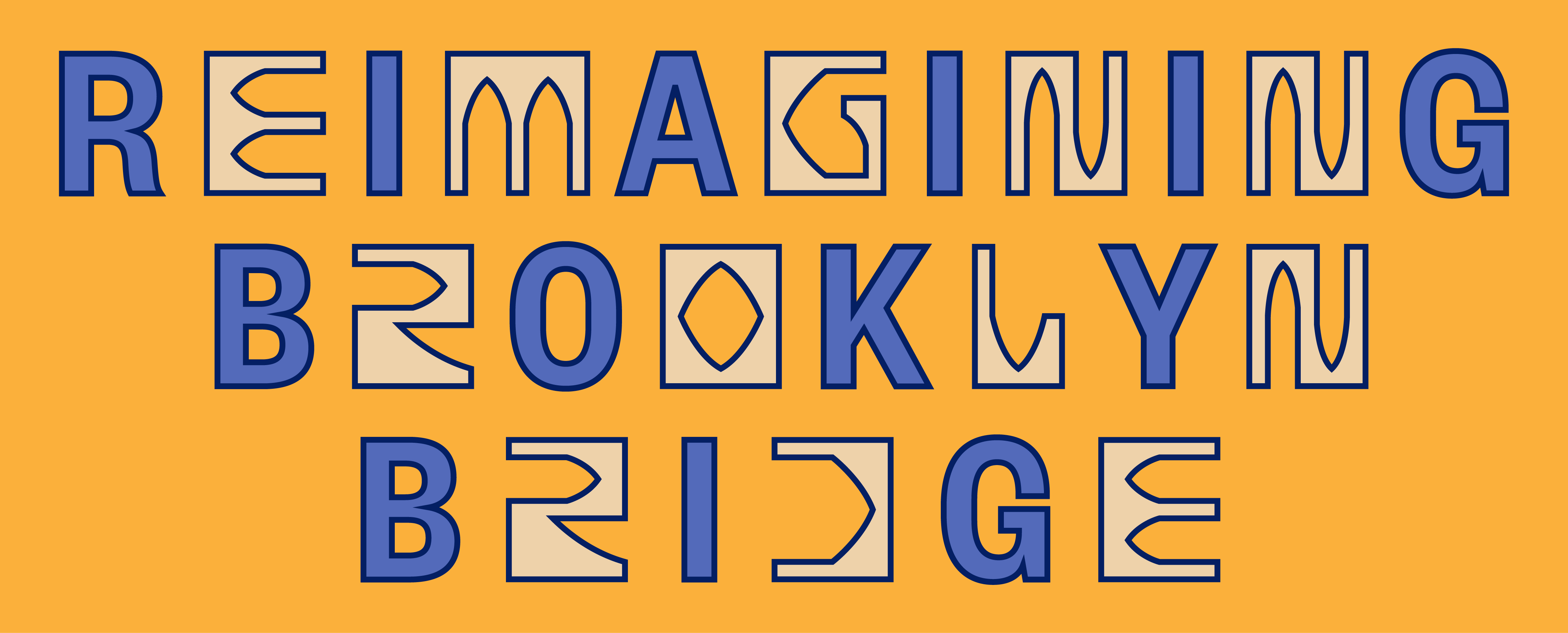Reimagining Brooklyn Bridge Finalists
July 9, 2020

Van Alen and New York City Council Announce Reimagining Brooklyn Bridge Finalists
In “Design Showdown” on July 23, public can hear from finalists and cast votes online
(July 9, 2020—New York, NY)—Van Alen Institute and the New York City Council today announced the six finalists for Reimagining Brooklyn Bridge, an international design competition that inspires participants to rethink the iconic Brooklyn Bridge walkway. As made even more clear by the pandemic, the design of our streets and shared spaces must be responsive to the present moment and work to correct past injustices. They must foster equitable, accessible, and sustainable transportation options, create a healthy and safe environment for all New Yorkers, and opportunities for small businesses and vendors to flourish.
The Brooklyn Bridge has the potential to serve as a testing ground for designs that serve our communities in need — not just in an imagined, idealistic future — but now. With these considerations at heart, the six finalist proposals are a compelling and optimistic set of ideas for responsive short-term interventions and longer-term, large-scale reconfigurations of the Brooklyn Bridge.
Finalists in the Young Adult category (ages 21 and under):
- The Artery, Lukas Kugler, New Milford, CT
- The Cultural Current, Aubrey Bader and Maggie Redding, Knoxville, TN
- Do Look Down, Shannon Hui, Kwans Kim, and Yujin Kim; Hong Kong, Bay Area, CA, and New York
Finalists in the Professional category (ages 22 and up):
- Back to the Future, BIG + ARUP, New York
- Bridge X, ScenesLab + Minzi Long + Andrew Nash; New York, Boston, and Vienna
- Brooklyn Bridge Forest, Pilot Projects Design Collective, Cities4Forests, Wildlife Conservation Society, Grimshaw and Silman; New York and Montreal
For select images from the finalist proposals, click here.
On Thursday, July 23 at 6 pm, finalists will present their proposals in a virtual Design Showdown. During the event, the public and the competition jury will have the chance to offer feedback and criticism for the teams. Each design will also be posted online at vanalen.org, where the public can cast votes for their favorite proposals between July 23–30. The winner will be announced in late summer.
RSVP for the Design Showdown here.
“With six lanes for traffic and one narrow, cramped right-of-way that pedestrians and cyclists must share, it’s clear that we haven’t been making the best use of the Brooklyn Bridge,” said Danny Harris, executive director of Transportation Alternatives and one of the competition’s jurors. “This design competition will expand the conversation about how to unlock this critical link, and as advocates fighting for a bike- and pedestrian-focused future, we’re glad to be a part of it.”
“For too long, the Brooklyn Bridge has been more geared toward serving cars than people. This competition is a unique opportunity to rethink that balance at a time when the city is facing an outsized need for public space,” said Regina Myer, President, Downtown Brooklyn Partnership and a competition juror. “A more pedestrianized bridge also complements work already underway to create continuous connections and public spaces around the bridge and down to the river as part of our Brooklyn Strand plan. Reorienting our infrastructure and roads to better serve pedestrians will enable us to create a greener and more cohesive Downtown Brooklyn that better serves our residents, businesses, and visitors both now and in the future.”
“The Brooklyn Bridge is one of New York City’s architectural gems and a beloved landmark, but it’s less successful as a functional public space,” said writer and editor Amy Plitt, also a competition juror. “And because of the COVID-19 pandemic, ensuring that the city’s public spaces are equitable, easily accessible, and safe for all is more important than ever. I hope this competition will help kickstart the conversation about how to make the Brooklyn Bridge a better space for all New Yorkers.”
ABOUT THE PROPOSALS
The Artery — Lukas Kugler, New Milford, CT
With sensitivity to different user groups, The Artery creates a contiguous modern transportation corridor between boroughs. On the bridge, the design incorporates designated spaces for vendors and three separate pathways for cyclists, runners, and pedestrians. The substantial incorporation of greenery provides natural borders between these paths, creating an improved experience while encouraging native plants and wildlife to inhabit the bridge.
The Cultural Current — Aubrey Bader and Maggie Redding, Knoxville, TN
Using a brightly colored path and cultural markers, The Cultural Current proposes a fluid integration of surrounding neighborhoods into a transportation and public space network that crosses the bridge. The proposal uses color in a playful way that’s also helpful for wayfinding, reuses existing wood boards and recycled plastic, and plans to phase car traffic off the lower roadway.
Do Look Down — Shannon Hui, Kwans Kim, and Yujin Kim; Hong Kong, Bay Area, CA, and New York
Do Look Down’s installation of a glass surface above the bridge’s girders creates a whimsical new pedestrian space activated through art installations and seasonal programming. The lower roadway is converted into additional walkable and human-powered transport space that also offers opportunities for local vendors and performers. Powered by kinetic paving, an LED and projection system is mobilized to honor the city’s cultures, histories, and identities.
Back to the Future — BIG + ARUP, New York
Back to the Future seeks to return the bridge to its original state, both architecturally and functionally, and pilots innovations in autonomous mobility and public space design. By removing cars and related ramps, and providing more space for pedestrians, bikes and transit, this proposal moves more people and creates a stronger connection between Downtown Brooklyn, Lower Manhattan, and beyond.
Bridge X — ScenesLab + Minzi Long + Andrew Nash; New York, Boston, and Vienna
Bridge X proposes a Brooklyn Bridge that evolves in response to public feedback and adapts from a pandemic to a post-pandemic era. Through a phased approach, Bridge X reimagines the upper and lower decks to reclaim space for greater pedestrian and cyclist access, to make room for vendors and small businesses, and to offer new modes of engagement with the bridge. Digital tools and design interventions enable visitors to more easily access, explore, and reflect on their experiences of the bridge.
Brooklyn Bridge Forest — Pilot Projects Design Collective, Cities4Forests, Wildlife Conservation Society, Grimshaw and Silman; New York and Montreal
Brooklyn Bridge Forest reimagines the bridge as an icon of climate action and social equity, improving mobility while respecting the landmark structure. The historic wooden walkway is expanded using planks sustainably sourced from a partner community in Guatemala that protects a 200,000-acre rainforest. A dedicated bike path and reclaimed traffic lane create new space for cyclists and low-carbon transit, while biodiverse “microforests” at either end of the bridge bring nature to New York City, and serve as green spaces for underserved communities.
About Van Alen Institute
Van Alen Institute envisions a world where cities, landscapes and regions support every human being’s full potential. To achieve this, we help communities build social and physical resilience through inclusive design. Building on 125 years of experience, we collaborate with communities, scholars, policymakers, and professionals on local and global initiatives that rigorously investigate the most pressing social, cultural, and ecological challenges of tomorrow.
With a core belief in an interdisciplinary approach to design, the Van Alen team has backgrounds in urban planning, public health, civic advocacy, community engagement, and arts and culture.
See all work at vanalen.org.
Contact
For select images from the finalist proposals, click here.
For more information and interview requests, email press@vanalen.org.

